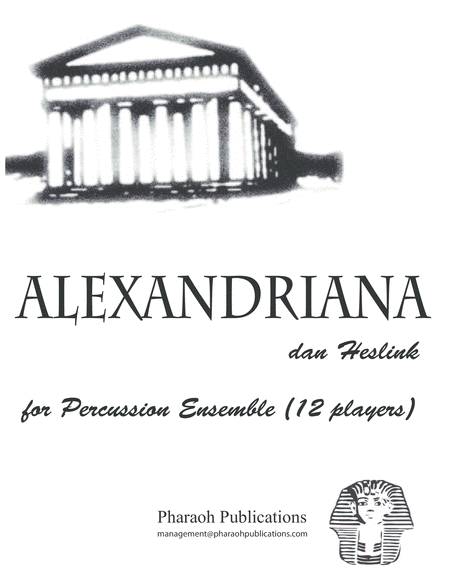Percussion Ensemble - Level 5 - Digital Download SKU: A0.937755 Composed by Dan Heslink. Contemporary,World. Score and parts. 128 pages. Pharaoh Publications #5983475. Published by Pharaoh Publications (A0.937755). Alexandriana for percussion ensemble (12 performers) by Dan Heslink The term Alexandriana is popularly used to reference the Great Library of antiquity in Alexandria, Egypt. Rooted in Alexander the Great’s global military and exploratory exploits (334 - 323 BCE), the library symbolizes the ancient Greek ever expanding worldview, especially under the influence of Alexander and his tutor, Aristotle. Alexander died long before construction of the Ancient Museum and Library of Alexandria, but the concept of a universal library was uniquely his. The mixing of Hellenistic columns with Egyptian architecture and the housing of thousands of scrolls in Greek, Turkish, Babylonian, Egyptian and Hebrew, intensify the division of the library broadly into two large sections, one for eastern knowledge and one for western knowledge. In this musical score, typically western is the thematic concept (expressed most clearly in the chimes), the tonal, triadic-based harmony and sectional concept of form. The music’s sectional nature parallels the library’s different rooms, each containing their own genre of knowledge (history, mathematics, poetry, etc.) Evocative of eastern musical practices are the simultaneous layers of different rhythmic subdivisions, oriental modes, and florid lines in the xylophone and vibe parts. In this score, eastern musical procedures are expressed with instruments commonly found in the Western orchestra or wind band. The performers are encouraged to always emphasize the score’s contrasts. Passages for indefinitely pitched percussion featuring the song within the drums contrast with other passages of purely quantitative rhythm. Complexity in the interaction of parts contrast with simple rhythmic unison. Passages of thick harmony contrast with modal monophonic melodies accompanied only by indefinitely pitched sounds. Overall, there is a wide dynamic range. During long passages of gradually accruing energy, take care to not build dynamics too quickly, and during fortissimo passages, drums should be stroked in a manner that avoids excessive aggression. The rhythmic background of 16th notes must be consistent among all players so that interlocking rhythmic motifs are consistent. Often the tom-toms have melodic passages that imitate the shape of mallet or timpani melodies. Tune the drums for a warm, round sound and select mallets accordingly. Bar percussion players should apply a flowing legato to their passage work. Soft sections are intended to sound mysterious: be sure to use mallets that match that character. The composer assigns a performance level of difficult to this work. Performance time is 9:15. The composer, Dan Heslink, can be reached at dan@dheslink.com.
